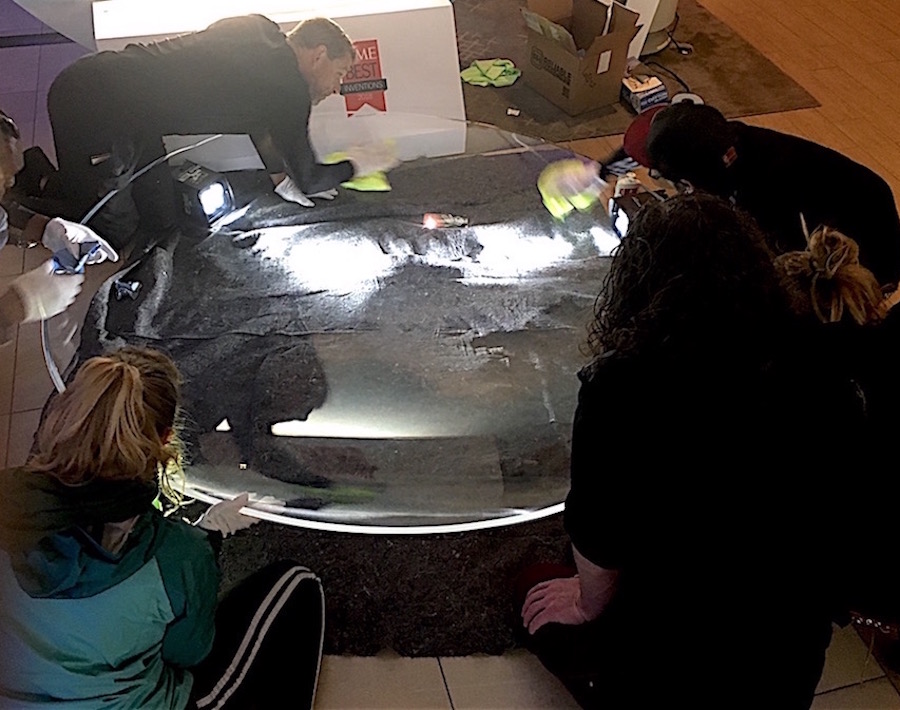What If Your Contact Lenses Could Change with the Light?
Acuvue debuts Oasys with Transitions, all eyes breathe a sigh of relief
By Wayne Alan Brenner, 8:00AM, Wed. Apr. 3, 2019
I went to a thing at SXSW this year.

Well, I went to a lot of things at SXSW this year – as I do every year. Because I’m a longtime reporter with The Austin Chronicle, and I’m assigned to go to things. Or because some PR entity has invited me to go to a thing where food and cocktails are part of the deal if not the whole raison d’etre of it – and damned if I can’t get behind a deal like that.
It’s what we call All In A Day’s Work for this Texas-based journalist.
But there was one thing that I went to at SXSW this year that I hadn’t been assigned to cover. Nor did I care about any attendant food or drink or swag or whatever.
No, I responded to the invitation and I went to the thing – the event, the activation, the press conference, whatever taxonomy you want to foist on it – because I shouldn’t have been able to see the invitation.
Because I’m what’s called “legally blind.” Because I’ve been more heavily spectacled than an Indian cobra since I was four years old. Because it was my dismal vision (or lack thereof) that was partly responsible for my dismissal from the United States Air Force when I was 18.
Because, without corrective measures, I couldn’t even recognize your own sweet face as human, dear reader, if you were standing ten inches away from me.
So, corrective measures – typically, contact lenses – are very important to me.
And the invitation I’d gotten was from Acuvue, the manufacturers of the Oasys brand of disposable lenses that I constantly wear. Because Acuvue had some news they wanted to share, and the news turned out to be (as – who says it? Will Ferrell as Ron Burgundy in that Anchorman movie?) a pretty big deal.
Because Acuvue’s Oasys with Transitions … are lenses that can sense variations in light conditions and adjust themselves – swiftly, smoothly – from clear to dark and back again, according to however the light changes.
You know – like some of those cool sunglasses that work so well that way.
That kind of tech, that kind of facility. In a disposable contact lens from a major manufacturer. In my preferred brand.
So, yes, in the midst of all the virtual reality and film and music and comedy and Southby gladhanding and debauchery and so on, I hauled myself over to the Westin hotel and I spoke to Jacqueline Henderson: the vice president of marketing and e-commerce for Johnson & Johnson Vision Care. I spoke to her about contact lenses. Because I was, tbh, a little excited by this new thing. And I definitely had some questions to ask.
If you’ve read this far, I reckon you might be interested in the answers:
Brenner: What led Acuvue to make these things in the first place?
Henderson: Well, light. If you think about it, indoors, outdoors, whether it’s a bright, sunny day or a cloudy day like today – light is all around us. And 64% of consumers will report that they’re bothered by light. So we wanted to see if we could develop a product that would help with that.
Brenner: But, ah, light-reactive sunglasses, like Foster Grants or whatever, those lenses have been around forever. So why contacts only now?
Henderson: This has been over ten years in the making – and that may seem like a really long time for a contact lens. But, through that ten years, we’ve tested it with over a thousand patients, done lots of clinical studies, to understand the performance of the lens and how people feel about it. And we’ve gotten some really positive feedback. And this is the first time that Acuvue is launching a contact lens that’s way beyond just vision correction. The lens’s light-management is a whole new benefit. It’s the first of its kind, and it’s got Transitions Light Intelligent Technology.
Brenner: Which means … ?
Henderson: So, Acuvue Oasys is a partnership between Acuvue and Transitions Optical, and Transitions Optical is the worldwide leader in photochromic spectacles. And, over ten years ago, we partnered with them – and our R&D teams have been working together to figure out how we could bring this technology into a contact lens. Which, from a technical perspective, is really, really tough to do.
Brenner: I can imagine.
Henderson: If you have specific questions about that, eventually I can connect you with some of our technology people, but for right now – I’m just the marketing girl.
Brenner: Oh, sure, no – just the basics are good.
Henderson: Okay, well, we chose to put the technology on our Acuvue Oasys platform, which is our two-week platform, that’s made with a material called Senofilcon A. And I mention that because not all contact-lens materials are the same – a lot of them are very different. And we take the photochromic additive and actually polymerize it throughout the total lens. That means it’s not dipped in anything.
Brenner: Ah, I was wondering. So it’s not, like, a film? A filter on the surface?
Henderson: It’s trillions of molecules actually inside the lens, so it has a nice homogeneous impact on the lens and seamlessly transitions from light to dark. It’s … pretty darn cool.
Brenner: That does sound cool. And kudos to your marketing department for not using the word “nanotechnology” anywhere. Because, even if it was accurate, I’m sick of that, I hate that term.
[laughter]
Henderson: Also, as maybe you already know because you wear them, every Acuvue lens has UV protection – but this new lens has the highest level of UV protection we’ve ever had in a contact lens – it blocks over 99% of UVA light and 100% of UVB light. But, as I was saying, the Transitions lens adapts from light to dark – it’s a smart lens that knows the light, that knows what to do.
Brenner: Like those sunglasses.
Henderson: What a lot of people don’t realize is that the light-adaptive lenses in glasses also respond to temperature – so when it’s colder, they’re a little slower to respond. But these contacts are always on your eyes, so they’re around body temperature – and that allows for a much more consistent and fast performance. So it lets you recover from sudden bright-bright light about five seconds faster than you normally could. Which, especially in the case of athletes, five seconds can mean a lot. And of course you get a lot less squinting – about 38% less squinting. Like, starburst effects and halos during night-time driving, that’s something else the technology has a positive impact on.
Brenner: Seems like there’d be a lot of military applications for these lenses, too. And astronauts and, ah, rescue workers?
Henderson: Many applications, yes. And another thing I want to mention is the cosmetic effect. It took a long time to figure out how much photochromic material to use, because we wanted to manage getting the best benefits while also controlling what the cosmetic effects would be. So the lenses darken, but not so dark that they block the iris – because everybody has neat colors in their irises, right?
Brenner: Are there other companies working on this technology or are y’all totally beating them to the punch?
Henderson: What I would say is, I don’t know. But I do know that we are definitely first in the category. And it’s taken over ten years to do this because the science is quite challenging – and the manufacturing is challenging, too. For instance, we cure our lenses on the line with UV light – which, you can see why that would be a problem with this particular lens. So we had to completely redesign the process in order to make this work. And there’s just so much technology involved, a lot of technical firsts, that it’d be hard for anyone else to – also, our partner Transitions Optical is the authority and patent-owner on a lot of photochromic additives.
Brenner: Okay, do the polymers – the, ah, photochromic materials – affect the regular use of the lenses? Do you have to clean them more often, change them more often?
Henderson: No, it’s a two-week replaceable lens – just like the regular Oasys Two-Week. And there’s no difference in terms of the contact lens solutions you can use.
Brenner: Is there a greater consumer cost for these lenses? Am I gonna have to refi my mortgage to help pay back all that Acuvue R&D?
Henderson: Well, there is a premium cost. An annual supply will cost you between $350 and $500, depending on how the doctor or retailer decides to price the product. So it’s a little more than our current Oasys Two-Week, but it’s still less expensive than a single-use deal.
Brenner: That’s around what I pay now, yeah, just a little more. Okay. Okay, cool.
Henderson: I think you’ll find that it’s well worth it.
A note to readers: Bold and uncensored, The Austin Chronicle has been Austin’s independent news source for over 40 years, expressing the community’s political and environmental concerns and supporting its active cultural scene. Now more than ever, we need your support to continue supplying Austin with independent, free press. If real news is important to you, please consider making a donation of $5, $10 or whatever you can afford, to help keep our journalism on stands.
March 22, 2024
March 22, 2024
Acuvue, light-reactive contact lens, Oasys with Transitions, photochromic materials, Jacqueline Henderson, Johnson & Johnson Vision Care, Wait – BRNNR was in the USAF?








